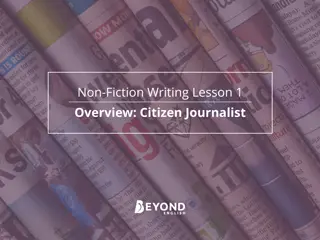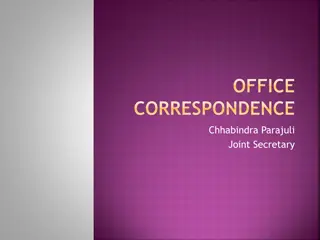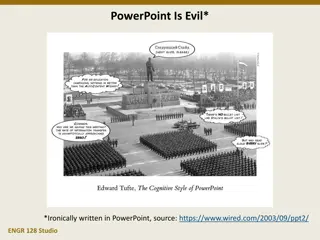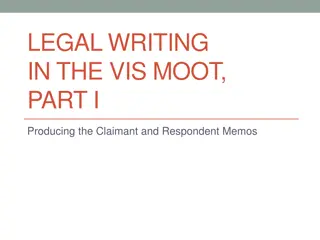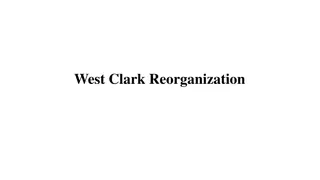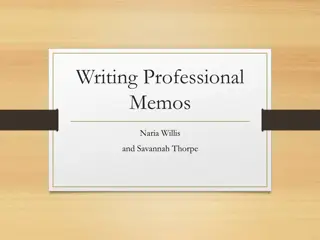Guidelines for Writing Professional Memos
Memos are brief printed documents used for routine communication within organizations. They typically begin with specific titles like MEMO or MEMORANDUM, followed by standard headings such as TO, FROM, DATE, and SUBJECT. The body of a memo should be concise, structured, and professional, with no need for salutations or closings. Using bullet points and maintaining a formal tone are essential for effective communication through memos.
Download Presentation

Please find below an Image/Link to download the presentation.
The content on the website is provided AS IS for your information and personal use only. It may not be sold, licensed, or shared on other websites without obtaining consent from the author.If you encounter any issues during the download, it is possible that the publisher has removed the file from their server.
You are allowed to download the files provided on this website for personal or commercial use, subject to the condition that they are used lawfully. All files are the property of their respective owners.
The content on the website is provided AS IS for your information and personal use only. It may not be sold, licensed, or shared on other websites without obtaining consent from the author.
E N D
Presentation Transcript
Created by Hunter Brown Summer 2013
Memos are brief printed documents traditionally used for the routine, day-to-day exchange of information within an organization.
Begins with title indicating that this is a memo This is a sample memo. Uses four standard headings Body does not begin with a salutation Uses bullet points to improve readability Does not end with a complimentary close or a signature block
Many companies have memo stationery with the company name or logo at the top. Stationery is optional, however. Memos typically begin with titles such as MEMO, MEMORANDUM, INTERNAL MEMORANDUM, or INTEROFFICE CORRESPONDENCE. Usually, the title is written in all caps and is centered or left-aligned.
The four standard headings for memos are TO:, FROM:, DATE:, and SUBJECT: (or Re:, short for Regarding). These headings can be arranged in almost any order, but the order shown above is the most common. The information following these headings should be aligned (see sample memo). The subject line should be short and informative. It may overflow to a second line if necessary.
The body should begin two or three lines below the heading. Salutations, such as Dear Employees or Hello, Everyone are unnecessary. The body is usually single-spaced with one blank line between each paragraph; however, very short memos may be double-spaced. Indenting paragraphs is optional. If a memo extends to a second page, head the second page as you did the first.
No complimentary closing or signature block is necessary. Courtesy titles, such as Dr. or Ms., need not be used in memos, unless you would use the courtesy title when speaking to the addressee face-to-face (e.g., Mr. President). Use bulleted lists to improve readability and to draw readers attention to the key points of your memo. Do not use slang or informal language. Strive for a tone that is professional, but not stuffy. In many companies, it is standard practice to sign your initials next to the FROM line.
Using the rules on the previous slides, can you find the errors in this memo?
(1) The headings should be capitalized, (2) the information following them should be aligned, (3) the Dr. preceding the recipient s name should probably be removed, and (4) the subject line should probably be compressed. The body should not begin with a salutation. The boxed words in the body of the memo are informal and should be upgraded. The memo should not end with a complimentary close or a signature block.
The errors have now been corrected. The complimentary close and signature block have been removed.
Do not include a salutation. Do not use slang or informal language. When appropriate, use bulleted lists to improve readability. Do not include a complimentary closing or signature block.
Bovee, Courtland L., and John V. Thill. Business Communication Today. 10th ed. Boston: Pearson, 2012. Print.


